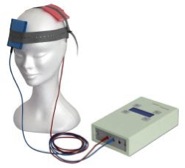Transcranial Electric Stimulation (TES)
Transcranial Electric Stimulation (TES)
 Transcranial electric stimulation (TES) is an umbrella term that encompasses different forms of noninvasive neuromodulation that involve passing current between electrodes placed on the scalp in order to affect underlying brain structures. Specific TES approaches include but are not limited to tDCS and tACS. TDCS involved the application of a continuous constant low level of direct current (typically 1-2mA), with the objective of creating small but significant changes in the firing rates of large numbers of neurons, leading to measurable changes in brain function and behavior. By contrast, tACS involves the application of similarly low amounts of current, but the delivery of this current alternates at specific frequencies. These rhythmic oscillation patterns are similar to patterns of activity normally present in the brain and can be used to influence both brain activity and their related behaviors. Because the currents being delivered in both tDCS and tACS are quite low (much weaker than those administered in electroconvulsive therapy, ECT), no serious adverse health effects have been associated with the appropriate use of these technologies. Nonetheless, Subjects considering participation in a TMS study should know that there are medical conditions that may preclude them from receiving TMS. It is important to discuss these with investigators and to undergo proper screening prior to receiving TMS.
Transcranial electric stimulation (TES) is an umbrella term that encompasses different forms of noninvasive neuromodulation that involve passing current between electrodes placed on the scalp in order to affect underlying brain structures. Specific TES approaches include but are not limited to tDCS and tACS. TDCS involved the application of a continuous constant low level of direct current (typically 1-2mA), with the objective of creating small but significant changes in the firing rates of large numbers of neurons, leading to measurable changes in brain function and behavior. By contrast, tACS involves the application of similarly low amounts of current, but the delivery of this current alternates at specific frequencies. These rhythmic oscillation patterns are similar to patterns of activity normally present in the brain and can be used to influence both brain activity and their related behaviors. Because the currents being delivered in both tDCS and tACS are quite low (much weaker than those administered in electroconvulsive therapy, ECT), no serious adverse health effects have been associated with the appropriate use of these technologies. Nonetheless, Subjects considering participation in a TMS study should know that there are medical conditions that may preclude them from receiving TMS. It is important to discuss these with investigators and to undergo proper screening prior to receiving TMS.

